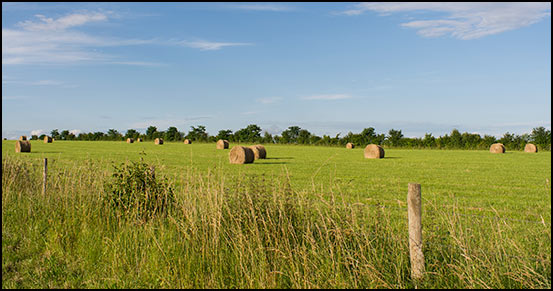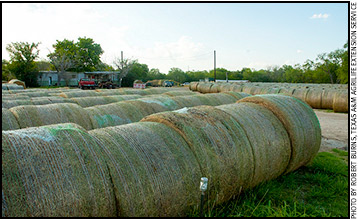
Hay Bales are an Investment
Worth Protecting
Reduce forage losses and save money by properly storing bales.
Hay season is ramping up and Texas A&M AgriLife Extension Service agent Fred Hall, Tarrant County, wants to remind producers that bales are an investment worth protecting.
Hay quality is a key component to animal performance and proper hay storage is a key component to hay quality, Hall said. Hay loss can be expected, even under a barn, so mitigation and risk management are the keys to protecting as much of your investment as possible.
“They get a fantastic bale made, and, by not moving them off-field, they endanger the stand and lose quality forage for their livestock,” Hall said. “Storing bales properly can reduce losses and save producers money.”
Once bales have cured, they should be taken to a permanent storage area and stacked, he said. The cutting, baling and hauling represents much of the cost of baled hay. Depending on yield, a 1,500-pound (lb.) bale can cost up to $45 to cut, roll and transport.
If the bale is valued at $100, the forage in the bale is worth $55. It makes sense to protect bales and the $45-per-bale investment as much as possible, Hall said.
When bales are stored outside and uncovered, weathering may affect hay quality up to 12 inches (in.) deep, he said. The depth will vary based on factors such as regional climate, the bale’s density, the storage location and methods of protection used to mitigate weathering.
The general expectation, however, is there will be a 4- to 6-in. weathered layer for bales stored outside on the ground. This is important, Hall said, because the outer portions of bales make up a substantial portion of the bale’s volume.
Bales left in fields are exposed to the elements in all directions, he said. If 3 in. of the outside surface of a 5-foot-by-6-foot bale are spoiled, it represents about 30% of the hay in that bale. In a 1,500-lb. bale, a 30% loss represents 450 lb. of hay.
Storage options
Producers should remove bales from fields as soon as possible to prevent damage to the hay and to the field, Hall said. Storing bales properly reduces the number of exposed surfaces and can reduce losses, especially if shelter is provided. Storing hay in barns can be a cost-effective method of protecting it for some producers. Barn storage protects the hay’s nutritional value and aesthetics. Plastic wraps can also be used to reduce losses.
Hall said hay stored outside is subject to wetting and drying cycles that degrade and leach nutrients from bales. Over time, this causes the fiber component of the forage, which is indigestible, to represent a larger percentage of the bale’s dry weight. The loss of total digestible nutrients (TDN) can often be as much as 15%-20% in weathered bales.

Hundreds of round hay bales for sale near Kaufman. Storing hay outdoors can lead to losses due to weathering. Proper storage methods can reduce losses and save forage and money.
Bales left in the field often flatten out and soften, which makes loading, handling and hauling those bales difficult because some bales will fall apart and dry-matter losses will increase, Hall said. To reduce losses on hay stored outdoors, run rows of hay bales on an upland site away from shade trees. Sunshine speeds up the drying process.
Hall recommends placing bales in a north-south orientation, with southern exposure. Set bales in rows so that the flat sides are touching and the round sides are separated. This keeps rain from ponding on top of bales.
Also, Hall said, rows should be at least 3 feet apart to allow for sunlight and good air circulation. Keeping bales off the ground, either by using pallets, crossties or rocks, is critical in preventing substantial losses, especially in rainy seasons.
Texas A&M AgriLife studies suggest that often 50% or more of the storage losses associated with outside storage occur where the bale touches ground. Dry hay touching damp soil draws moisture into the bale.
Some producers store bales in the “mushroom” style, where bottom bales are on end, Hall said. This style provides less protection than end-to-end, especially if the rows are tight to each other. It’s been found that the bottom bales also tend to act as a wick and draw moisture from the ground.
The result of poor storage techniques is a weathered layer that is very low in quality and unpalatable to livestock, he said.
The next cutting
Leaving hay in the field for extended periods of time can inhibit forage growth.
Forage plants smothered by a hay bale will be suppressed until the bale is removed. The longer the bale stays in one spot, the less likely the forage plants will recover. The area becomes a prime site for weed invasion if the bales set for more than a week. Weed-control costs add to the variable cost of the next crop or fixed costs if the field has to be renovated, he said.
Accessing moist fields can also cause damage to forage, especially legumes and forbs. Wheel traffic can hurt regrowth, he said.
AgriLife Extension agricultural economist Jason Johnson, Stephenville, said protecting hay through proper storage is protecting the time and money invested during production.
It is better to have not made a hay crop than to make a crop, incur the expenses and let it waste away and negatively affect regrowth, he said. “In the end you will lose more money with that scenario than if you had never harvested a single bale.”
For more information about protecting hay check out the publication Round Bale Hay Storage at http://agrilife.org/urbantarrantag/.
Editor’s Note: Adam Russell is a communications specialist with Texas AgriLife Communications.







